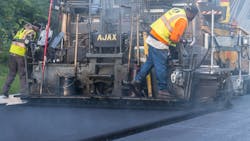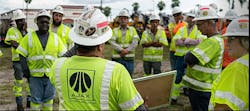“It’s a dirty job, but somebody’s got to do it” isn’t funny anymore. Not only are contractors facing labor shortages, but workers are also demanding safer conditions and continuous training to ensure that they will go home in one piece at the end of the day.
Asphalt paving job sites can become slow-moving accident sites, putting them in the top five most dangerous construction work zones for struck-by and fall incidents.
The Department of Labor’s Center for Construction Research and Training says the construction industry employs 7.3% of the nation’s workforce. Yet, according to figures from the U.S. Bureau of Labor (BLS), it has three times as many deaths: 21.7%. Accurate totals for nonfatal injuries, defined as those that caused workers to have days away from work by the BLS Survey of Occupational Injuries and Illnesses (SOII), are hard to determine due to inconsistencies in employee/employer reporting.
What causes accidents on road projects?
Research on construction worker safety associated with construction equipment has mostly focused on accident type rather than injury severity using data from the Occupational Safety and Health Administration. Additionally, accidents involving on-foot workers and equipment operators are investigated collectively, as well as separately.
A 2018 study, “Worker safety and injury severity analysis of earthmoving equipment accidents,” found these human variables were significantly associated with injury severity and produced the highest odds for fatal accidents:
- Inadequate safety training
- Missing equipment protective system
- Being a nonunion worker
- Being an equipment operator
- Being on or around inadequately maintained equipment
Struck-by accidents were the most prevalent and most fatal. Non-OSHA-compliant safety training, missing seatbelts and operators not using seatbelts, malfunctioning back-up alarms, and poorly maintained equipment were factors contributing to accidents and fatalities. On-foot workers experienced a higher number of accidents than operators, while fatality odds were higher for the operators. Read how onboard cameras can help equipment operators see workers, reducing struck-by accidents.
Even during the pandemic when there were fewer construction workers on the job, there was a 4.2% increase in the fatal injury rate from 2019 to 2020. Construction laborers and helpers endured 43.3% of the recorded deaths. Falls and struck-by deaths, especially on road and highway construction projects, ranked second only to structures and surface accident (roofing, scaffolding, confined spaces) fatalities. Unfortunately, less experienced and less skilled labor helpers are the most vulnerable.
Asphalt equipment training
- Astec Industries offers in-person classes including Asphalt Customer Schools, Paving Professionals Workshops, and Asphalt Construction Heater Schools.
- Blaw-Knox University provides classroom and hands-on operations hot mix paving training.
- BOMAG offers training courses ranging from applications to regulations, with coursework specifically targeting paving crew members.
- Caterpillar’s Paving Training is a four-and-a-half day course. Each day has two hours of classroom instruction and six hours of hands-on training at a paving site.
- The Clarence Richard Co. features online safety programs using virtual classrooms and webinar training for operators and managers.
- Wirtgen’s training facility—including a 5-acre test track—trains safe work practices on and around asphalt pavers.
- Sakai’s regional managers and dealers will come to a contractor’s location for hands-on training.
Granted, passing motorist traffic is a major safety hazard, but it would be incorrect to assume motorist vehicles were the primary cause of construction worker deaths and injuries. Despite safety features such as emergency stop buttons, fire suppression systems, and fall prevention equipment built into today’s paving machines, 55% of struck-by incidents were caused by fellow crew members, construction vehicles, or equipment, according to the NIOSH Fatality Assessment and Control Evaluation (FACE). That elusive variable on job sites—human error—too often overrides mechanical safety protections.
Proximity detection and alert systems provide hazard avoidance alerts in real time, but human awareness is what keeps workers safe. When asphalt paving personnel are confident in their skills, fewer opportunities for injury occur.
A key component of worker safety is frequent and consistent training says Mandy Kustra, safety director for Ajax Paving Ind. Of Florida.
“Keep your people educated. They want to learn,” Kustra says. “Companies need to take advantage of the training that manufacturers such as Cat or Sakai offer for your pieces of equipment. We bring operators in for smaller classes, maybe 10 people or less, so they can just focus on the roller that they operate.”
Ajax Paving has a 15-member safety committee with representation from every level of the company: Laborers, operators, foremen, and management regularly review safe work practices, work zone safety, incidents, PPE, and safety policies to ensure a safe working environment.
Kustra suggests making use of weather-induced downtime to offer safety classes.
“Take advantage of the training that manufacturers and dealers offer,” she says. “[Employees]…frequently thank us for bringing in equipment dealers and manufacturers because they cover topics that we didn’t consider.”
Recent accidents involving asphalt paving equipment
- A 43-year-old worker was electrocuted while operating a paving machine in Westbury, New York.
- An Elkhart County, Indiana, construction worker was killed while cleaning a paving machine and becoming entangled in the machine’s auger.
- A 25-year-old roller operator was killed in Butler County, Ohio, when the roller malfunctioned, causing him to lose control.
- An Omaha man died after crashing into an asphalt paver.
- A 23-year-old asphalt sealant company employee was killed while unloading supplies from the back of work truck.
- A Baltimore construction worker died after being struck by an asphalt roller.
- An Indiana construction worker was killed when an asphalt paving truck backed over him.
- A construction inspector was struck and killed by equipment at a Pembroke, New York, repaving project.

